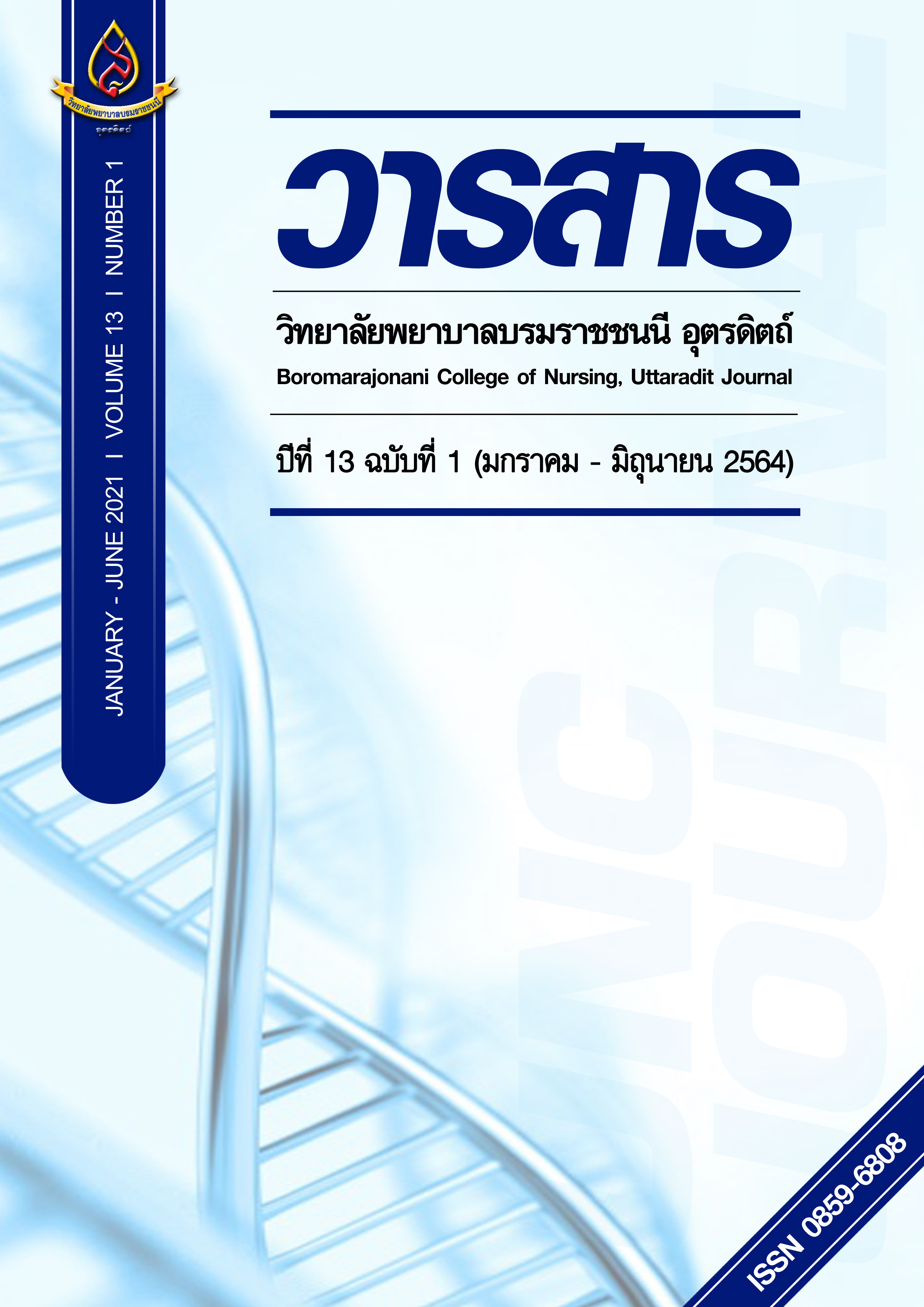การพัฒนาระบบสุขภาพสำหรับหญิงตั้งครรภ์วัยรุ่นที่ตั้งครรภ์โดยไม่ได้ตั้งใจ
Main Article Content
บทคัดย่อ
การตั้งครรภ์ที่ไม่ได้ตั้งใจในวัยรุ่นเป็นปัญหาสำคัญประการหนึ่งที่มีแนวโน้มเพิ่มขึ้น การเจริญเติบโตอย่างรวดเร็วของสังคมเมืองส่งผลโดยตรงต่อการเปลี่ยนแปลงวัฒนธรรมทางสังคมที่ขัดเกลาทัศนคติและพฤติกรรมทางเพศรวมทั้งความเชื่อทางเพศที่ไม่เหมาะสมโดยเฉพาะในกลุ่มวัยรุ่น การตั้งครรภ์ที่ไม่ได้ตั้งใจในวัยรุ่นส่งผลกระทบทั้งด้านสุขภาพทางกายและใจของวัยรุ่นและครอบครัว นอกจากนี้ยังเกิดผลกระทบด้านสังคมและเศรษฐกิจในระดับประเทศ ส่วนใหญ่การตั้งครรภ์ในวัยรุ่นนั้นจะเป็นการตั้งครรภ์ที่ไม่ได้ตั้งใจ โดยมีปัจจัยที่เกี่ยวข้องกับการตั้งครรภ์ที่ไม่ได้ตั้งใจทั้งปัจจัยในระดับบุคคลและระดับสังคมสิ่งแวดล้อม ดังนั้นการศึกษาในครั้งนี้จึงใช้การใช้โมเดลเชิงนิเวศวิทยา (ecological model) ในการวิเคราะห์ปัจจัยดังกล่าวเพื่อให้เห็นปฏิสัมพันธ์ของปัจจัยดังกล่าวที่มีอิทธิพลต่อการตั้งครรภ์ที่ไม่ได้ตั้งใจในวัยรุ่น
บทความวิชาการนี้มีวัตถุประสงค์เพื่อศึกษาการพัฒนาระบบสุขภาพของหญิงตั้งครรภ์วัยรุ่นที่ตั้งครรภ์โดยไม่ได้ตั้งใจโดยใช้โมเดลเชิงนิเวศวิทยา ซึ่งปัญหาของหญิงตั้งครรภ์วัยรุ่นที่ตั้งครรภ์โดยไม่ได้ตั้งใจเป็นปัญหาที่มีความซับซ้อน ดังนั้นการใช้โมเดลเชิงนิเวศวิทยาทำให้สามารถอธิบายความสัมพันธ์เชื่อมโยงกับปัจจัยต่าง ๆ ทั้งระดับบุคคล ระดับระหว่างบุคคล ระดับองค์กร ระดับชุมชน และระดับนโยบาย ผลของการศึกษานี้จะนำไปสู่การพัฒนาระบบสุขภาพในการป้องกันการตั้งครรภ์ที่ไม่ได้ตั้งใจในวัยรุ่นที่เหมาะสมกับสังคมไทยต่อไป
Article Details
บทความหรือข้อคิดเห็นใดใดที่ปรากฏในวารสารวิจัยการพยาบาลและวิทยาศาสตร์สุขภาพ เป็นวรรณกรรมของผู้เขียน ซึ่งบรรณาธิการหรือสมาคมศิษย์เก่า ไม่จำเป็นต้องเห็นด้วย และบทความที่ได้รับการตีพิมพ์เผยแพร่ถือเป็นลิขสิทธิ์ของวารสารวิจัยการพยาบาลและวิทยาศาสตร์สุขภาพ
เอกสารอ้างอิง
Aeamsamarng, P., Srisuriyawet, R. & Homsin, P. (2013). Risk factors of Unintended repeat pregnancy among adolescents. The Public Health Journal of Burapha University, 8(1), 55-67. (in Thai).
Beauchamp, T.L., & Childress, J.F. (2013). Principles of Biomedical Ethics. 7 thed. New Jersey: Pearson Education.
Boonyaporn, T., & Saetan, C. (2017). Nursing role: stress management of pregnant teenage. The Southern College Network Journal of Nursing and Public Health, 4(3), 271-281. (in Thai).
Bronfenbrenner, U. (1979). The Ecology of human development: experiments by nature and design. Cambridge, MA: Harvard University Press.
Buchan, J. & Dal-Poz, M. R. (2012). Skill mix in health care workforce: reviewing the evidence. Bulletin of the World Health Organization, 80(7), 575-580.
Exavery, A., Kante, A. M., Hingora, A. Mabaruku, G., Pemba, S. & Phillips, J. F. (2013). How mistimed and unwanted pregnancy affect timing of antenatal care initiation in three districts in Tanzania. Pregnancy and Childbirth, 13(35), 1-22.
Johnson, F. A. & Madise, N. J. (2009). Examining the geographical heterogeneity associated with risk of mistimed and unplanned pregnancy in Ghana. Journal of Biosocial Science, 41, 249-267.
Mchunu, G., Peltzer, K., Tutshana, B. & Seutlwadi. (2012). Adolescent pregnancy and associated factors in Sounth African youth. African Health Science, 12(4), 426-434.
McLeroy KR, Bibeau D, Steckler A, Glanz K. (1988). An ecological perspective on health promotion programs. Health education quarterly, 15, 351-77.
Mekkamol, K. & Wichainprapha, A. (2018). The roles of nurses in teenage mother’scaring. Journal of Health Science Research, 12(2), 69-77 (in Thai).
National Health Security Office of Thailand. (2011). The universal coverage project. Retrieved (2013, November 1) from: http://www.Nhso.go.th.
National Prevention Council. (2011). National prevention strategy america’s plan for better health and wellness. Office of the Surgeon General.
Pedrosa, A. A., Pires, R., Carvalho, P., Canavarro, M. C. & Dattilio, F. (2011). Ecological contexts in adolescent: The role of individual, sociodemographic, Familial and relational and adjustment pattern. Contemporary Family Therapy, 33, 107-127.
Phromchaisa P, Kantaruksa K, Chareonsanti J. (2014). Effect of social support enhancement on maternal role among adolescent pregnancy women. Nursing Journal, 41(2), 97-106.
Pungbangkadee, R. & Serisathien, Y. (2008). Nurses: Support and care of unwanted pregnant. Journal of Nursing Science, 26(2), 5-16.
Rahman, M. (2012). Women, s autonomy and unintended pregnancy among currently pregnancy women in Bangladesh. Maternal Child Health, 16, 1206-1214.
Rowland, S. (2010). Social predictors of repeat adolescent pregnancy and focused strategies. Best Practice & Research Clinical Obstetrics and Gynaecology, 24, 605-616.
Saejeng, K., Sukrat, B., Kovavisarat, E., Pomprapat, P., & Kanjanawetang, J. (2015). A practical guide for teenagers. Bangkok: Media Center and Kaewchaochom Publications. (in Thai).
Sauls D. J. & Grassley J. S. (2012). Evaluation of the supportive needs of adolescents during childbirth intrapartum nursing intervention on adolescents’ childbirth satisfaction and breastfeeding rates. Journal of
Obstetric, Gynecologic, & Neonatal Nursing, 41(1), 33–44.
Silva R. B., Contandriopoulos, A. P., Pineault R. & Tousignant P. (2011). A global approach to evaluation of health service utilization: Concepts and measures. Health care Polic, 6(4), 106-117.
Srijaiwong, S., Sindhu, S., Ratinthorn, A., & Viwatwongkasem, C. (2017). Factors influencing sexual behaviors among Thai adolescents. Journal of Population and Social Studies, 25(3), 171-193. doi: 10.25133/JPSSv25n3.002
Srisuriyawet, R. & Homsin, P. (2014). Mother-daughter sexual risk communication and psychosocial factors related to sexual experience among female students. The Public Health Journal of Burapha University, 9(2), 33-44. (in Thai).
Thato, S., Rachakul, S. & Sopajaree, C. (2007). Obstetrics and perinatal outcomes of Thai pregnant adolescents: A retrospective study. International Journal of Nursing Studies. 44, 1158-1164.
Tilghman, J., & Lovette, A. (2008). Prenatal care: The adolescent’s perspective. Journal of
Perinatal Education, 17, 50–53. doi:10.1624/105812408X298390
Tipwareerom, W., Powwattana, A., Rarpwongwattana, P. (2013). Predictors of risky sexual behaviors among adolescent boy, Phitsanulok province. Journal of Public Health Nursing, 27(1), 31-45. (in Thai).
Vivancos, R., Abubakar, I., Phillips-Howard, P. & Hunter, P. R. (2012). School-based sex education is associated with reduced risky sexual behaviour and sexually transmitted infections in young adults. Public Health, 127(1), 53-57. doi: 10.1016/j.puhe.2012.09.016
Vuttanont, U., Greenhalgh, T., Griffin, M. & Boynton, P. (2006). Smart boys and sweet girls and sex education needs in Thai teenager: A mixed method study, Lancet, 368, 2068-2080.
Waters, S. K., Cross, D. S. & Runions, K. (2009). Social and ecological structures supporting adolescent connectedness school: A theoretical model. Journal of School Health, 79(11), 516-524.
World Health Organization. (2012). Adolescent Pregnancy (Issues in Adolescent health and Development) Retrieved (2019, November 2) from http://www.who.int/mediacentre.
Yakasem, P. & Sittirit, S. (2012). Experiences of registered nurses in providing prenatal care for pregnant teenagers. Journal of Nursing and Education, 5(3), 145-156. (in Thai).
Zolna, M. & Lindberg, L. (2012). Unintended Pregnancy: Incidence and outcomes among young adult unmarried women in the United States. New York: Guttmacher Istitute.


